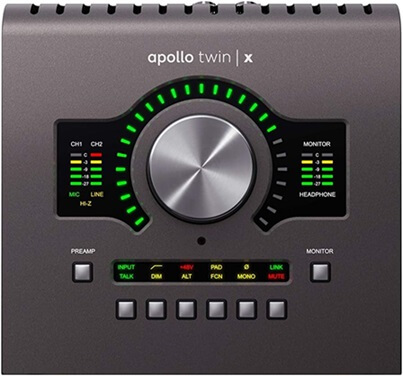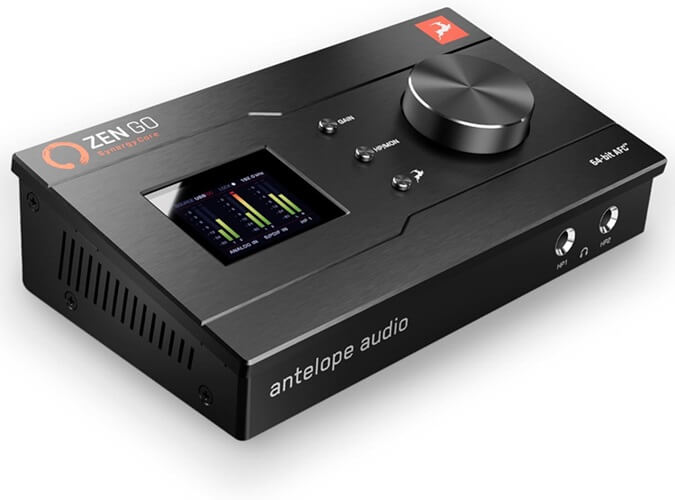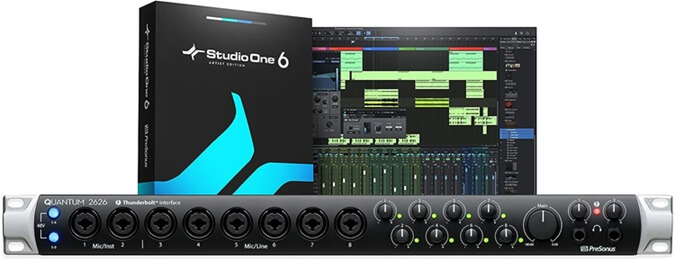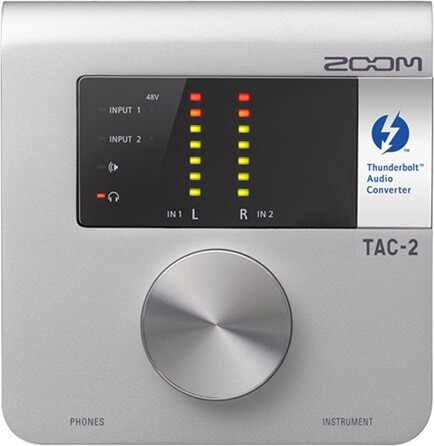Thunderbolt audio interfaces offer the highest performance and lowest latency of any type of audio interface, making them ideal for professional recording studios and musicians who demand the best possible sound quality. Thunderbolt also offers a wide range of features and connectivity options, making it a versatile solution for a variety of applications.
Top Features to Look for When Buying a Thunderbolt Audio Interface
- I/O Configuration: Consider the audio interface’s inputs and outputs (I/O) based on your needs. For solo recording, a few I/O suffice, but for band or orchestra recording, opt for an interface with more I/O.
- Converter Quality: The converter quality of an audio interface affects the sound quality of your recordings. Look for an interface with high-quality converters that will capture your audio accurately without distortion.
- Preamp Quality: The preamp quality of an audio interface matters a lot, especially if you’re recording vocals or acoustic instruments. Look for an interface with preamps that have good gain and clarity.
In this article, we’ll take a look at some of the Best Thunderbolt Audio Interfaces available in the market. We’ll also discuss the key features to look for when choosing an interface and provide a “Buying Guide“ to help you make the best decision for your needs.
Outline
ToggleBest Thunderbolt Audio Interface Table
| Best Thunderbolt Audio Interface | Dynamic Range | Bit Depth | Buy Now |
|---|---|---|---|
| Universal Audio Thunderbolt Audio Interface | 127 dB | 32-bit | Check On Amazon |
| Antelope Audio Thunderbolt Audio Interface | 127 dB | 64-bit | Check On Amazon |
| PreSonus Thunderbolt Audio Interface | 120 dB | 24-bit | Check On Amazon |
| Zoom Thunderbolt Audio Interface | 120 dB | 24-bit | Check On Amazon |
| Antelope Audio Thunderbolt Audio Interface | 121 dB | 64-bit | Check On Amazon |
Best Thunderbolt Audio Interface Reviews
1. Universal Audio Thunderbolt Audio Interface

Best Features:
- Elite-class A/D and D/A conversion
- Unison-enabled preamps for classic analog sound
- Real-time UAD plug-in processing
- Type C thunderbolt
- LUNA Recording System for seamless workflow
Pros:
- Excellent sound quality
- Powerful UAD plug-in processing
Cons:
- High price
2. Antelope Audio Thunderbolt Audio Interface

Best Features:
- High-quality preamps and converters
- Proprietary 64-bit AFC technology
- Suite of 37 analog-modeled effects
- Professional studio sound quality
- Type C thunderbolt
- Wide range of creative processing options
Pros:
- Portable and convenient design
- Intuitive controls
Cons:
- Some issues with Windows 11
3. PreSonus Thunderbolt Audio Interface

Best Features:
- Blazing-fast speed for real-time tracking and monitoring with plug-ins.
- Pristine audio quality with 24-bit/192kHz converters and XMAX preamps.
- Expansive I/O with 26 inputs and 26 outputs.
- Type C thunderbolt
- Versatile connectivity with Thunderbolt 3, ADAT Optical, S/PDIF, and BNC.
- Award-winning software included.
Pros:
- Low latency.
- Expandable.
- Versatile connectivity.
Cons:
- Large size.
4. Zoom Thunderbolt Audio Interface

Best Features:
- High-quality AD/DA converters
- Asynchronous transfer technology
- Burr Brown mic preamps
- +60 dB of gain and +48V phantom power
- Balanced TRS outputs
- Mini display port thunderbolt
- Headphone output with dedicated level control
- Compatible with Windows and Mac computers
- Comes with MixEfx software mixer and Ableton Live Lite
Pros:
- Exceptional audio quality
- Ultra-low latency
- Versatile inputs and outputs
- Comprehensive software bundle
Cons:
- Some issues macOS High Sierra(10.13.6)
5. Antelope Audio Thunderbolt Audio Interface

Best Features
- Exceptional sound quality
- 37 real-time analog-modeled plugins
- Up to 32 plugins loaded simultaneously
- Flexible software mixer
- Mini display port thunderbolt
- Compact and lightweight
Pros
- Versatile connectivity
- Real-time plugin processing
Cons
- Synergy Core plugins can be demanding on the CPU
Buying Guide for Best Thunderbolt Audio Interface
1. I/O Configuration
The I/O configuration of a Thunderbolt audio interface refers to the number of inputs and outputs it has. Inputs are used to connect your microphones, instruments, and other audio devices to your computer. Outputs are used to connect your speakers, headphones, and other audio devices to your computer.
The most common I/O configurations for Thunderbolt audio interfaces are:
- 2-in, 2-out
- 4-in, 4-out
- 8-in, 8-out
- 16-in, 16-out
- 24-in, 24-out
Which I/O configuration you need will depend on your specific needs. If you’re just recording yourself, you might get away with a two-in, two-out interface. But if you’re recording a band or producing music with lots of tracks, you’ll need an interface with more inputs and outputs.
2. Converter Quality
The converter quality is what determines how good your recordings will sound. The converters are responsible for converting your analog audio signal to digital audio. High-quality converters will accurately capture the sound of your instruments and vocals, while low-quality converters will introduce noise and distortion into your recordings.
When choosing a Thunderbolt audio interface, look for one with high-quality converters. Common converter brands include AKM, Burr-Brown, and ESS.
3. Preamp
The preamps in a Thunderbolt audio interface amplify your signal before it’s converted to digital audio. Good preamps will give your recordings a clean and clear sound.
When choosing a Thunderbolt audio interface, look for one with high-quality preamps. Some interfaces have preamps that are designed to emulate the sound of classic analog preamps.
4. Thunderbolt Port Types
There are three main types of Thunderbolt ports:
- Thunderbolt 1: Thunderbolt 1 uses a Mini DisplayPort connector.
- Thunderbolt 2: Thunderbolt 2 also uses a Mini DisplayPort connector, but it is backward compatible with Thunderbolt 1.
- Thunderbolt 3 and 4: Thunderbolt 3 and 4 use a USB-C connector, which is also reversible.
5. Latency
Latency is the delay between when you play a note and when you hear it back in your headphones or monitors. Thunderbolt interfaces offer ultra-low latency, so you can play and record in real-time without any delay.
Latency is important for musicians and producers who need to be able to monitor their performances in real-time. It’s also important for engineers who need to be able to record and edit audio without any delay.
6. Sample Rate and Bit Depth
The sample rate and bit depth determine the quality of your digital audio recordings. The sample rate is the number of times per second that your audio signal is sampled. The bit depth is the number of bits used to represent each sample.
Higher sample rates and bit depths will produce higher-quality recordings, but they will also require more storage space and processing power.
For most recording applications, a sample rate of 44.1 kHz and a bit depth of 16 bits is sufficient. However, if you’re recording high-resolution audio, you’ll need to use a higher sample rate and bit depth.
Thunderbolt Audio Interface – FAQs
Ans: No, Thunderbolt interfaces work with both Mac and Windows systems.
Ans: Thunderbolt offers faster data transfer and lower latency.
Ans: Yes, many Thunderbolt interfaces are compact and suitable for laptops.
Ans: Yes, a Thunderbolt cable is necessary for the connection.
Ans: If you prioritize audio quality and low latency, a Thunderbolt interface is worth it.
Conclusion
If you are looking for the best possible audio recording and playback quality, a Thunderbolt audio interface is the way to go. Thunderbolt interfaces offer superior performance and features, such as low latency, high sample rates, and support for multiple channels.
- When choosing a Thunderbolt audio interface, it is important to consider your needs and budget. If you are a professional musician or producer, you may want to consider a high-end interface like the Universal Audio Thunderbolt Audio Interface.
- If you are on a budget, there are still several great Thunderbolt interfaces available, such as the Zoom Thunderbolt Audio Interface.
No matter what your needs or budget, there is a Thunderbolt audio interface that is perfect for you. With a Thunderbolt interface, you can be sure about the best possible audio recording and playback quality. Also, feel free to share your queries regarding its selection and usage with us in the below comments section. We will respond and resolve them promptly.

